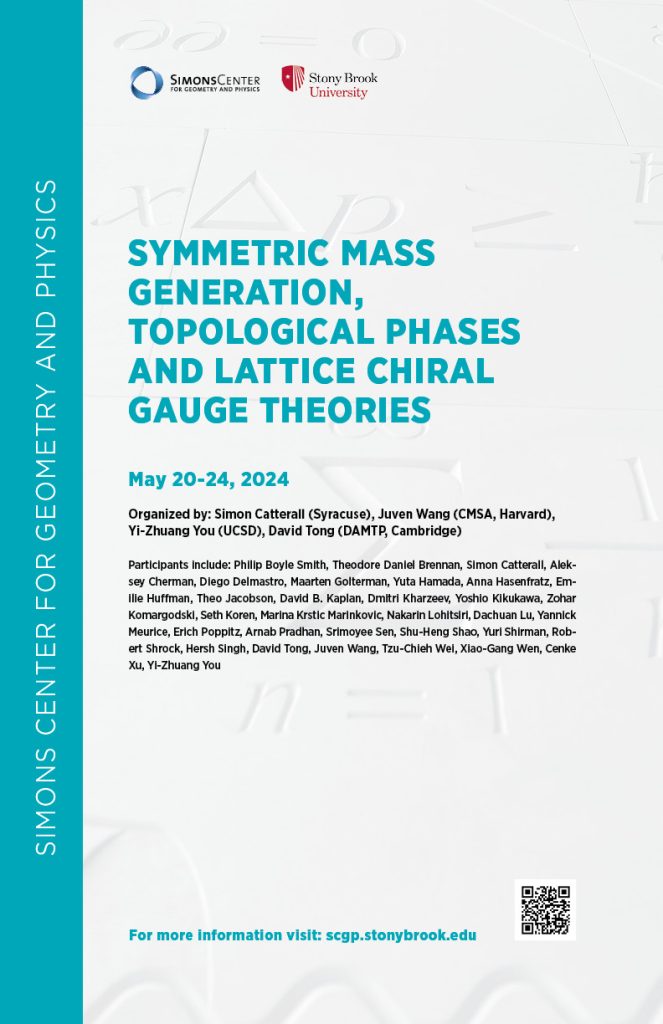ScheduleAttendee ListView Videos
Organized by:
- Simon Catterall (Syracuse)
- Juven Wang (CMSA, Harvard)
- Yi-Zhuang You (UCSD)
- David Tong (DAMTP, Cambridge)
The most common mechanism for generating fermion masses arises when scalar fields acquire vacuum expectation values in theories with Yukawa interactions. Such a mechanism is necessarily associated with the spontaneous breaking of symmetries. However, recent work in both the condensed matter and high-energy physics communities has shown that this is not the only possibility — in certain theories, fermions can acquire masses without breaking chiral symmetries. Examples of such symmetric mass generation can be found in gapped boundary states of topological superconductors and observations of massive symmetric phases in staggered lattice fermions. The key constraint that allows such a mechanism to operate is the cancellation of all ‘t Hooft anomalies, both perturbative local and non-perturbative global anomalies in the theory. In the context of lattice gauge theories, this has led to renewed hope that it should be possible to construct classes of anomaly-free chiral lattice fermion theories using mirror models. There is also a growing interest in understanding the nature of the gap-opening transition and the unique signature that characterizes the symmetric gapped phase. Other possible applications and future directions of symmetric mass generation include supersymmetric or non supersymmetric duality, the flavor hierarchy problem, the strong CP problem, and applications to gapping the Fermi surfaces in strongly correlated electron systems.
| Time |
Title |
Speaker |
Location |
| 8:30am |
Breakfast |
N/A |
SCGP Cafe |
| 9:30am |
Chiral Gauge Theory at the Boundary between Topological Phases |
David Kaplan |
SCGP 103 |
| 10:30am |
Coffee Break |
N/A |
SCGP Cafe |
| 11:00am |
Conserved currents in five-dimensional proposals for lattice chiral gauge theories |
Yigal Shamir |
SCGP 103 |
| 11:30am |
Propagator zeros and lattice chiral gauge theories |
Maarten Golterman |
SCGP 103 |
| 12:00pm |
Lunch |
N/A |
SCGP Cafe |
| 1:30pm |
Non-invertible and chiral symmetries |
Shu-Heng Shao |
SCGP 103 |
| 2:30pm |
Weyl fermions on a finite lattice |
Srimoyee Sen |
SCGP 103 |
| 3:30pm |
Tea Time |
N/A |
SCGP Cafe |
| 4:00pm |
Boundaries, Anomalies, Scattering |
Diego Delmastro |
SCGP 103 |
| Time |
Title |
Speaker |
Location |
| 8:30am |
Breakfast |
N/A |
SCGP Cafe |
| 9:30am |
Various aspects of symmetric mass generation |
Cenke Xu |
SCGP 103 |
| 10:30am |
Coffee Break |
N/A |
SCGP Cafe |
| 11:00am |
Tensor networks for lattice field theory |
Gertian Roose |
SCGP 103 |
| 11:30am |
Tensor networks for generalized symmetries, duality and chiral fermions |
Laurens Lootens |
SCGP 103 |
| 12:00pm |
Group Photo |
N/A |
SCGP Lobby |
| 12:00pm |
Lunch |
N/A |
SCGP Cafe |
| 1:30pm |
Generalized lattice gauging |
Dachuan Lu |
SCGP 103 |
| 2:00pm |
Gauge response of Green’s function zeros |
Yi-Zhuang You |
SCGP 103 |
| 2:30pm |
Three approaches to chiral fermion problem via mirror fermions: composite fermion, anomaly, and non-linear sigma model |
Xiao-Gang Wen |
SCGP 103 |
| 3:30pm |
Tea Time |
N/A |
SCGP Cafe |
| 4:00pm |
Workshop Discussion Session |
N/A |
SCGP 103 |
| Time |
Title |
Speaker |
Location |
| 8:30am |
Breakfast |
N/A |
SCGP Cafe |
| 9:30am |
Exact lattice anomalies and SMG for Kaehler-Dirac fermions |
Simon Catterall |
SCGP 103 |
| 10:30am |
Coffee Break |
N/A |
SCGP Cafe |
| 11:00am |
Phase structure of 8 flavor SU(3) gauge theory |
Anna Hasenfratz |
SCGP 103 |
| 11:30am |
SMG in four dimensional staggered fermion models |
Nouman Butt |
SCGP 103/ZOOM |
| 12:00pm |
Lunch |
N/A |
SCGP Cafe |
| 1:30pm |
Generation Puzzle (3= 48/16 = 45/15 = 24/8) and Strong CP Puzzle |
Juven Wang |
SCGP 103 |
| 2:30pm |
SMG=MG |
Phillip Boyle Smith |
SCGP 103 |
| 3:30pm |
Tea Time |
N/A |
SCGP Cafe |
| 4:00pm |
The integrability of chiral determinant in anomaly-free chiral lattice gauge theories |
Yoshio Kikukawa |
SCGP 103 |
| 6:00pm |
Banquet Dinner |
N/A |
SCGP Cafe |
| Time |
Title |
Speaker |
Location |
| 8:30am |
Breakfast |
N/A |
SCGP Cafe |
| 9:30am |
Modified Villain Hamiltonians and Lattice Chern-Simons Theory |
Theo Jacobson |
SCGP 103 |
| 10:30am |
Coffee Break |
N/A |
SCGP Cafe |
| 11:00am |
Exact lattice chiral symmetry in 2d gauge theory |
Aleksey Cherman |
SCGP 103 |
| 12:00pm |
Lunch |
N/A |
SCGP Cafe |
| 1:30pm |
Fermionic anomalies on the lattice: the Ginsparg-Wilson relation and its generalizations |
Hersh Singh |
SCGP 103 |
| 2:30pm |
Conformally Symmetric Views from a Fuzzy Sphere |
Emily Huffman |
SCGP 103 |
| 3:30pm |
Tea Time |
N/A |
SCGP Cafe |
| 4:00pm |
Monopole-fermion scattering and flavor hierarchy |
Yuta Hamada |
SCGP 103 |
| Time |
Title |
Speaker |
Location |
| 8:30am |
Breakfast |
N/A |
SCGP Cafe |
| 9:30am |
Generalized Global Symmetries and Nonperturbative Quantum Flavodynamics |
Seth Koren |
SCGP 103 |
| 10:30am |
Coffee Break |
N/A |
SCGP Cafe |
| 11:00am |
Chirality changing RG flows: dynamics and models |
Yuri Shirman |
SCGP 103 |
| 12:00pm |
Lunch |
N/A |
SCGP Cafe |





